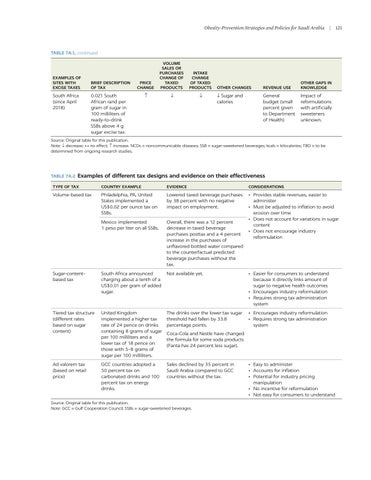Obesity-Prevention Strategies and Policies for Saudi Arabia
|
121
TABLE 7A.1, continued
EXAMPLES OF SITES WITH EXCISE TAXES
South Africa (since April 2018)
BRIEF DESCRIPTION OF TAX
PRICE CHANGE
VOLUME SALES OR PURCHASES CHANGE OF TAXED PRODUCTS
INTAKE CHANGE OF TAXED PRODUCTS
↑
↓
↓
0.021 South African rand per gram of sugar in 100 milliliters of ready-to-drink SSBs above 4 g sugar excise tax.
OTHER CHANGES
REVENUE USE
OTHER GAPS IN KNOWLEDGE
↓ Sugar and calories
General budget (small percent given to Department of Health)
Impact of reformulations with artificially sweeteners unknown.
Source: Original table for this publication. Note: ↓ decrease; ↔ no effect; ↑ increase. NCDs = noncommunicable diseases; SSB = sugar-sweetened beverages; kcals = kilocalories; TBD = to be determined from ongoing research studies.
TABLE 7A.2
Examples of different tax designs and evidence on their effectiveness
TYPE OF TAX
COUNTRY EXAMPLE
EVIDENCE
CONSIDERATIONS
Volume-based tax
Philadelphia, PA, United States implemented a US$0.02 per ounce tax on SSBs.
Lowered taxed beverage purchases by 38 percent with no negative impact on employment.
Mexico implemented 1 peso per liter on all SSBs.
Overall, there was a 12 percent decrease in taxed beverage purchases posttax and a 4 percent increase in the purchases of unflavored bottled water compared to the counterfactual predicted beverage purchases without the tax.
• Provides stable revenues, easier to administer • Must be adjusted to inflation to avoid erosion over time • Does not account for variations in sugar content • Does not encourage industry reformulation
Sugar-contentbased tax
South Africa announced charging about a tenth of a US$0.01 per gram of added sugar.
Not available yet.
• Easier for consumers to understand because it directly links amount of sugar to negative health outcomes • Encourages industry reformulation • Requires strong tax administration system
Tiered tax structure (different rates based on sugar content)
United Kingdom implemented a higher tax rate of 24 pence on drinks containing 8 grams of sugar per 100 milliliters and a lower tax of 18 pence on those with 5–8 grams of sugar per 100 milliliters.
The drinks over the lower tax sugar threshold had fallen by 33.8 percentage points.
• Encourages industry reformulation • Requires strong tax administration system
Ad valorem tax (based on retail price)
GCC countries adopted a 50 percent tax on carbonated drinks and 100 percent tax on energy drinks.
Sales declined by 35 percent in Saudi Arabia compared to GCC countries without the tax.
Coca-Cola and Nestle have changed the formula for some soda products (Fanta has 24 percent less sugar).
Source: Original table for this publication. Note: GCC = Gulf Cooperation Council; SSBs = sugar-sweetened beverages.
• Easy to administer • Accounts for inflation • Potential for industry pricing manipulation • No incentive for reformulation • Not easy for consumers to understand






